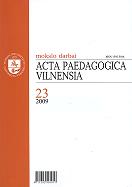NUOTOLINIO MOKYMO(SI) TURINIO PROJEKTAVIMO MODELIS: KOKYBĖS VERTINIMO DIMENSIJOS IR VEIKSNIAI
DISTANCE LEARNING / TEACHING CURRICULUM DESIGNING MODEL IN THE PERSPECTIVE OF QUALITY ASSESSMENT DIMENSIONS AND FACTORS
Author(s): Airina Volungeviciene, Margarita Teresevičienė, Rimantas LaužackasSubject(s): Education
Published by: Vilniaus Universiteto Leidykla
Keywords: nuotolinis mokymas1; nuotolinio mokymo turinio projektavimas2; turinio kokybės vertinimo veiksniai3; mokymosi strategijos4;
Summary/Abstract: The article addresses the problem that distance learning / teaching curriculum designers do not apply distance learning / teaching curriculum designing theories, and they do not estimate the needs of distance learning / teaching organization process. The majority of factors influencing distance learning / teaching curriculum quality are theoretically supported, but they are not applied by distance learning / teaching curriculum authors in Lithuania. The aim of the research is to prepare distance learning / teaching curriculum designing model on the basis of distance learning / teaching curriculum quality assessment factors and dimensions. The authors reveal the importance of distance learning / teaching curriculum designing quality assessment dimensions for distance learning/ teaching curriculum designing in the first part of the article. Distance learning / teaching curriculum quality assessment factors are identified in the second part of the article and they are correlated with the learning / teaching strategy consistency dimension. The last part is dedicated to present the model of distance learning / teaching curriculum designing, based on quality assessment factors. The conclusions of the research present consistent results with the theoretical parts of the paper: the importance of the dimesnion of distance learning/ teaching curriculum quality assessment for distance learning/ teaching curriculum designing, their interrelation with quality assessment factors, as well as their integration into distance learning / teaching curriculum designing model.
Journal: Acta Paedagogica Vilnensia
- Issue Year: 2009
- Issue No: 23
- Page Range: 9-20
- Page Count: 12
- Language: Lithuanian

